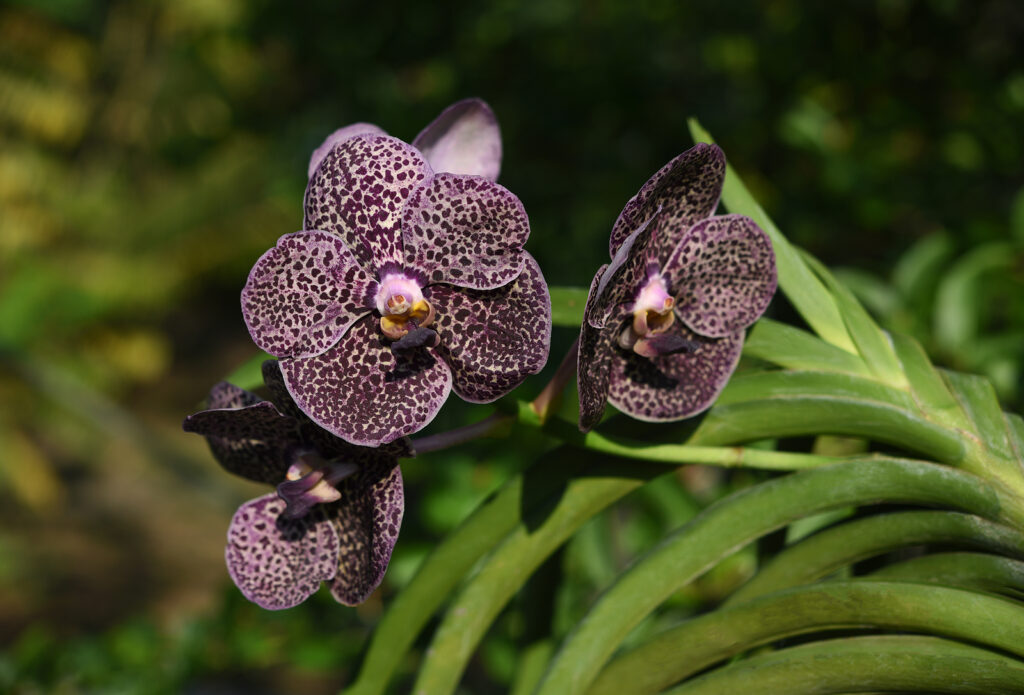Vanda is a genus of epiphytic, evergreen orchids that bear large showy flowers with intricately colored sepals. Flowers appear on a long spike in succession which means Vanda produces fresh flowers over an extended period. Vanda usually blooms twice a year.
Vanda flower colors include blue, deep mauve and indigo, pinkish purple, violet-blue, and pale yellow. Flowers are usually patterned.
Vanda is a genus of about 40 species native to India, Southeast Asia, and the Philippines.
Get to know Vanda
- Plant type: Epiphytic orchid
- Growing zones and range: Zones 11-15
- Optimal growing temperature: day, 65° (18°C) or higher; night, 58° to 65°F (14° to 18°C).
- Height and width: 24 to 36 inches (60-90cm) tall, 12 inches (30cm) wide
- Foliage: Strap-shaped to linear, leathery, semi-rigid, mid-green leaves; thick, simple stems, tips of stems bear leaves; aerial roots form on the lower part of stems
- Flowers: Large, showy flowers intricately colored on their sepals, with small lips; the flowers open along the spike in succession, which means there are fresh flowers appearing over an extended period of time. Flower colors includeblue, deep mauve and indigo, pinkish purple,violet-blue, and pale yellow
- Bloom time: Twice in a single year
- Uses: Houseplant, tropical garden
- Common name: Vanda
- Botanical name: Vanda
- Family name: Orchidaceae
- Origin: Tropics and subtropics India, Southeast Asia, and the Philippines.

Where to plant Vanda
- Light: Grow Vanda indoors in bright light from southern exposure; shade only during hottest part of the day. Good circulation of fresh air.
- Plant Vanda outdoors in a moist, shady location.
- Soil: Grow Vanda in Osmunda fiber or orchid bark mix. Vanda grows well in baskets or slotted pots in the home; also, can be grown on section of tree limb, barn board, cork bark, or slab of tree fern fiber in the greenhouse.
When to plant Vanda
- Set Vanda outdoors in a tropical or subtropical garden any time of the year.
Planting and spacing Vanda
- Space Vanda 12 inches (30cm) apart.
How to water and feed Vanda
- Water: Keep Vanda evenly moist; never allow growing medium to dry out. Mist aerial roots frequently. Humidity is best at 50%. Water Vanda moderately duirng the winter.
- Feeding: Fertilize Vanda with an all-purpose orchid food every third watering.
Vanda care
- Plant requires no rest period. Prefers slightly cooler and drier conditions prior to flowering.
- Repot when plant overcrowds pot space, or when growing medium has deteriorated. Best done at outset of active growth, when new roots are first visible.
Vanda pests and diseases
- Check Vanda for bacterial, fungal, and viral infections, mealybugs, scale, slugs, snails, whiteflies.
Vanda propagation
- Propagate Vanda by air layering, plantlets removed from stem, or stem cuttings.
- Remove offsets that grow from the base of the plant, or root cuttings of stem sections in spring.
Vanda varieties to grow
- Vanda coerulea, native to India, blooms from late summer to early autumn. Its 3 to 4-inch flowers come in shades of pale to dark blue.
- V. sanderana grows to 3 feet high; in autumn, it bears flat 3 to 4-inch flowers in combinations of white, rose, brown, greenish yellow, or red.
- V. teres, a Burmese native, is grown commercially in Hawaii, where it’s used extensively to make leis.Vanda tricolor. Grows to 36 inches (90cm) tall and 12 inches (30cm) wide; produces 6 to 12 blooms on an erect flower stalk; flowers have an odor reminiscent of grape juice and are pale yellow with brown spots; petals are twisted toward the back of the flower; fiddle-shaped lip is white with pink shading and purple stripes; blooms from spring to summer.
- V. tricolor var. suavis. Grows to 36 inches (90cm) tall and 12 inches (30cm) wide; bears 6 to 12 flowers on long and curving flower stalk; white blooms with purple stripes have twisted edges; white lip has pale yellow throat with purple stripes at base; flowers anytime throughout the year.















